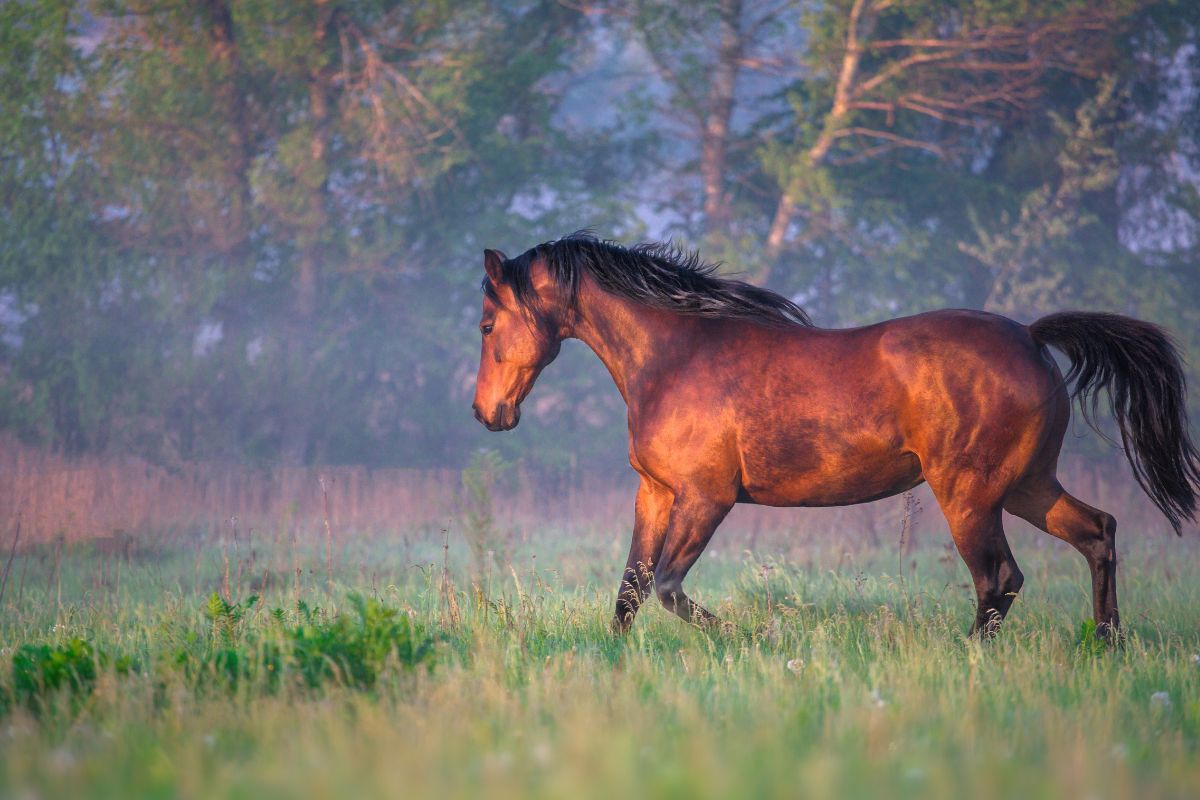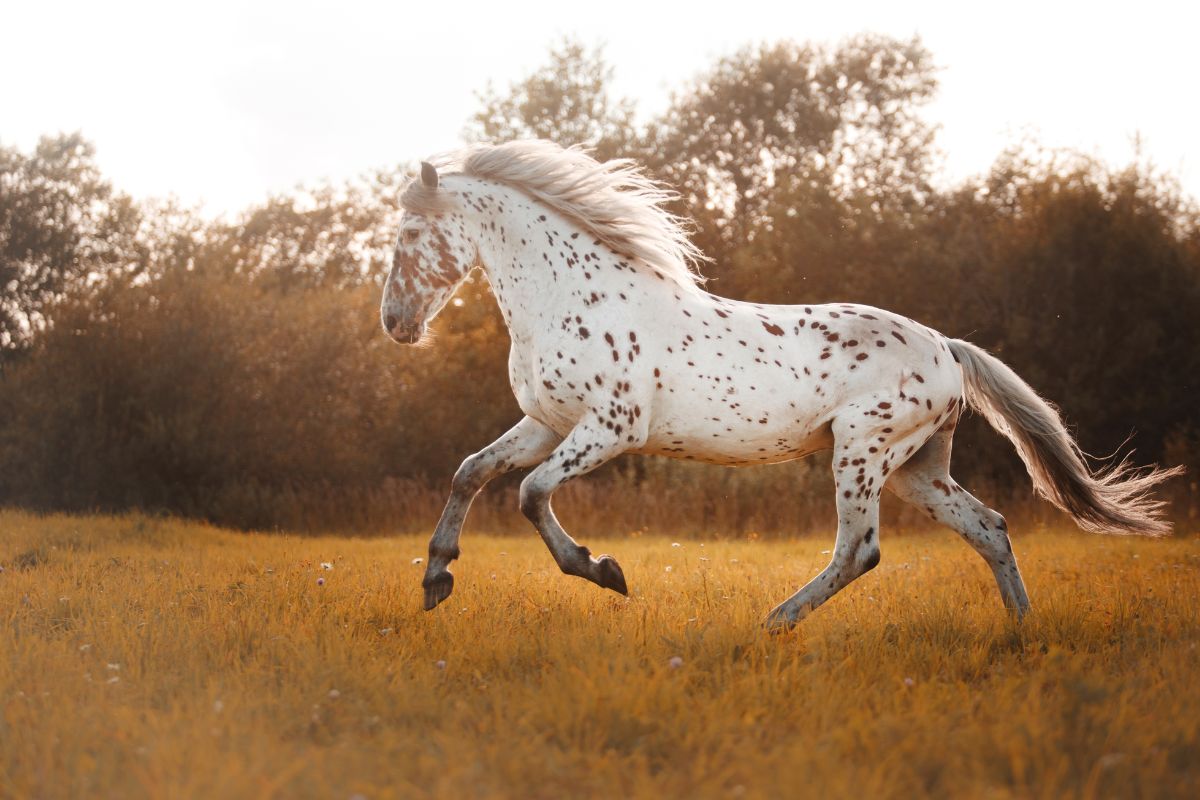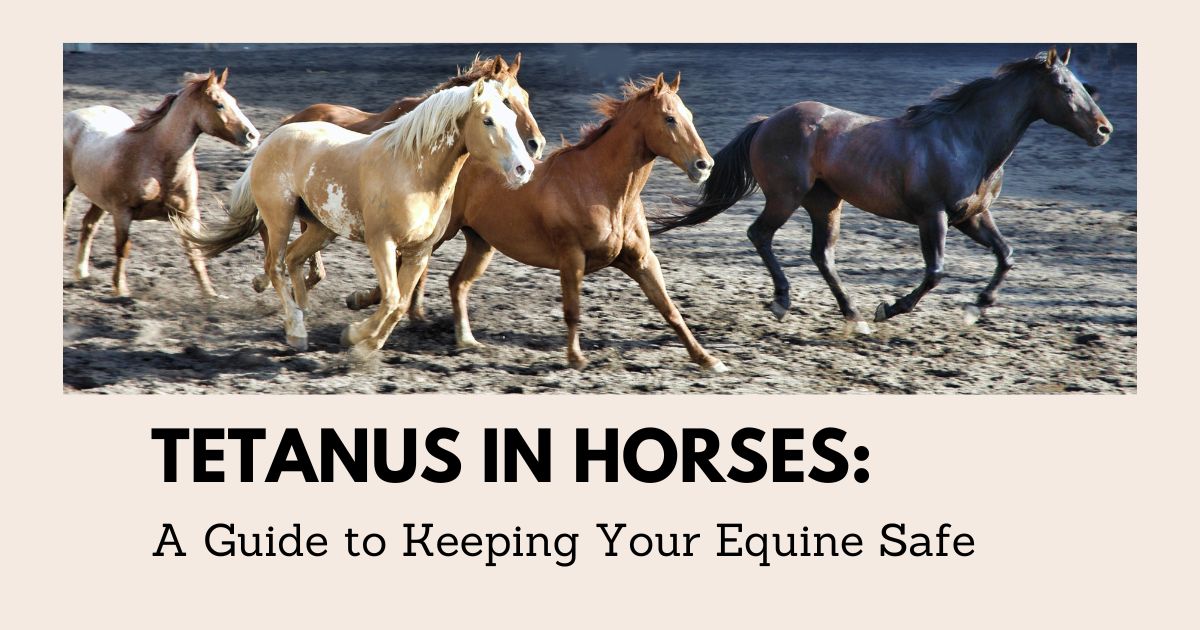What is Tetanus in Horses?
How much do you know about tetanus in horses? It is a potentially lethal disease characterized by muscle spasms caused by the bacterium Clostridium tetani. You can find these organisms and their spores in the intestines of horses and other animals.
The spores can enter open wounds, where they can grow if favorable conditions. When the spores die, they emit the neurotoxic tetanospasmin, which is responsible for the clinical symptoms.

The Causes of Equine Tetanus
The bacteria Clostridium tetani, which you can find in almost any soil or dropping, causes tetanus. It can live in the environment for extended periods. Also, it enters the body through wounds, particularly unclean puncture wounds. Puncture wounds on the horse’s feet soles are common infection sites.
Additionally, an infection can enter the horse’s body through the intestines after consuming infected dirt or droppings or through stomach or intestinal ulcers. As a result, the infection can spread through the umbilicus in foals. Read our article and find out 7 of The Best Ulcer Supplements for Horses .
You will realize tetanus bacteria do not require oxygen and grow fast in the injured tissues. They produce a poison (tetanus toxin) responsible for the classic tetanus symptoms.
Tetanus Symptoms in Horses
Tetanus symptoms appear three to twenty days after infection. As a result, the injured horse stiffens and has trouble moving and eating. Typical clinical signs include:
- The horse initially has a stiff gait and adopts a ‘saw horse’ stance, with all four limbs planted apart and the tail stretched out.
- The head and neck become extended, nostrils flared, ears pricked, and the jaw is ‘locked.’ Lockjaw in horses refers to the muscles becoming rigid; the horse can’t eat and may drool due to difficulty swallowing.
- The animal becomes hypersensitive to noise and touch, and spasms of the facial muscles cause the classic risus sardonicus, which pushes back the muscles of the lips, revealing the teeth in a tight-lipped smile.
- As the disease develops, the third eyelids prolapse across the eyes. This may not be noticeable initially, but any head movement can trigger the third eyelid to flash upwards.
- In fatal circumstances, the horse eventually collapses as the spasms deepen, and death occurs due to respiratory failure.
How to Vets Diagnose the Condition?
Tetanus is typically diagnosed based on clinical indicators and a recent wound history. Therefore the vets may culture C. tetani from the wound in some situations.
Treating Equine Tetanus
The majority of tetanus instances result in the death of the infected animal. Therefore, treatment aims to eliminate the bacteria, so there is no more toxin creation and reduce the consequences of the already produced toxin if detected early.
Additionally, during treatment, they combine high dosages of antibiotics, mainly penicillin, with tetanus antitoxin, commonly administered intravenously and intramuscularly. Also, they occasionally administer antitoxin into the area around the spinal cord (subarachnoid space).
During this time, you must nurse and keep the horse in a darkened, quiet stall to decrease muscle spasms and anxiety. Also, if the horse can eat, place the food at a height it can easily reach. You may require slinging in extreme instances. This entails suspending the horse’s weight from the ceiling or another support using a large leather or cloth strap.
Apart from that, intravenous fluids and bladder catheterization may also be necessary. However, if such procedures are a requirement, the possibilities of recovery are pretty low, and euthanasia on humane grounds is more suitable.

Are There Ways to Prevent Tetanus in Horses?
Tetanus is an avoidable disease. Therefore, tetanus toxoid for horses is essential for all horses and ponies. The initial treatment includes two tetanus shots for horses four to six weeks apart, followed by a one-year booster and other annual boosters.
If your unvaccinated horse gets injured, it should receive tetanus antitoxin, followed by toxoid, as soon as possible, if not simultaneously.
Moreover, you can protect foals during their first few weeks by immunizing their pregnant dams one month before foaling. This results in sound levels of protective antibodies in their colostrum, which the foal can suck and ingest.
You should give Tetanus antitoxin for horses to the foal shortly after birth and again at three to four weeks of age under conditions of intense foal treatment and if the mare did not receive a vaccine. Also, you should note that foals cannot respond to vaccines given before four months but should begin an equine tetanus vaccine (toxoid) course soon after.
Furthermore, you can avoid horse tetanus with proper first aid. Also, you should clean wounds as soon as possible and try to assist drainage of deeper injuries, such as poulticing. Paddocks, stables, and stable yards should be secure, clean, and free of potentially dangerous items such as old tractor parts, corrugated iron sheets, and building materials.
The Prognosis
Recumbent horses would have a poor prognosis, especially if clinical indications progressed swiftly. Affected horses that can stand have a good prognosis, with recovery taking 2 to 6 weeks. It is possible to recover completely. However, tetanus has links to up to 80% mortality in horses.
Interesting Facts About Tetanus in Equines
We know so much about tetanus in horses. Let us look at some interesting facts:
Horses are Especially Vulnerable
Horses are more susceptible to tetanus than other animals. As a result, a modest amount of the pathogen’s toxins can be fatal to them.
Tetanus Transmission Can be Through Almost Any Wound
In actuality, tetanus can result from any break in the skin that allows C. tetani spores to enter the body. Similarly, health officials warn that missed or improperly cleaned superficial wounds pose a greater tetanus risk than punctures or more severe injuries that are more likely to receive immediate and complete medical attention.
Furthermore, tetanus is a postpartum concern for mares and their newborn foals. Mares, after foaling, can get tetanus through uterine contamination, and foals are in danger from umbilical infections—though these cases are less common than those from puncture wounds.
The Incubation Period of the Disease Can Span Several Weeks
Many factors influence the onset of tetanus, including the location of the lesion, its severity, and the level of contamination. Moreover, tetanus spores stuck in well-oxygenated tissues may remain dormant after healing until a bruise or similar injury at the same spot produces conditions that activate the organism and allow it to reproduce.
Also, more foreign material in a wound means more C. tetani spores and faster growth. On the other hand, prompt detection, cleansing, and wound treatment reduce the risk of tetanus.
The Spread of Tetanus Depends on Where the Bacterium Enters the Body
The specific symptoms of tetanus depend on which nerves get the first impact. Motor neurons initially absorb the neurotoxins produced by C. tetani organisms near the original infection site and then spread along the nerve cells.
Further, the inciting wound in “ascending tetanus” is on a hoof or lower leg. The neurotoxin travels up the peripheral neurons to the spinal cord segments that govern that limb. This frequently causes muscle spasms, which mostly affect the limb that sustained the wound.
In addition, there’s the creation of more neurotoxic than the neurons can absorb in the local area. Therefore, the lymph system and bloodstream transport away the excess, eventually reaching the brain and spinal cord. As a result, muscle spasms in the head and jaw may develop fast in these circumstances.
Tetanus and Botulism Result From Microorganisms That are Closely Related
Clostridium botulinum and Clostridium tetani produce potent neurotoxins, but their effects on the body differ. C. botulinum produces a toxin that inhibits muscle contraction, resulting in paralysis, whereas C. tetani produce a toxin that prevents muscles from relaxing, resulting in spasticity.
Also, C. tetani’s neurotoxin attaches to nerve cells, preventing the release of a neurotransmitter that normally allows muscular contractions to stop. As a result, the muscles controlled by these neurons lock into agonizing spasms, which can occasionally be strong enough to break bones.
In contrast, the neurotoxin C. botulinum has the opposite effect, preventing muscles from contracting. As a result, horses with botulism may lose the capacity to swallow because the diaphragm muscles become flaccid.
Although Tetanus Has a High Death Rate, it is Treatable
When outward signs of tetanus develop, a horse is in terrible condition, and saving it will require heroic efforts.
The sooner it begins treatment, the better its chances of surviving. In that case, if you can treat the horse before the toxin can make its way into the spinal cord, the horse will probably do better than if the wound remains unnoticed. Also, if you delay treatment, the horse is less likely to recover.
Tetanus has no known treatment. Instead, supportive treatment and other interventions aim to lessen the severity of the symptoms and keep the horse alive. At the same time, the disease progresses over several days to several weeks.

We’ve Got You Covered
Regardless of therapy, fifty to seventy percent of horses infected with tetanus die. However, because effective core vaccines for horses are now available, horse owners can protect themselves and their animals from this terrible disease.
Tetanus, sometimes known as lockjaw, is a disease that affects the central nervous system of horses. Because it is not contagious, it cannot spread from animal to animal. Instead, Clostridium tetani, a bacteria prevalent in the intestinal tracts of many animals, including horses and humans, causes the sickness.
Furthermore, the bacterium is usually in the manure, contaminating the soil. It could linger in the environment for years, and you can find it all around the globe. Moreover, the sickness can infect both horses and people.
